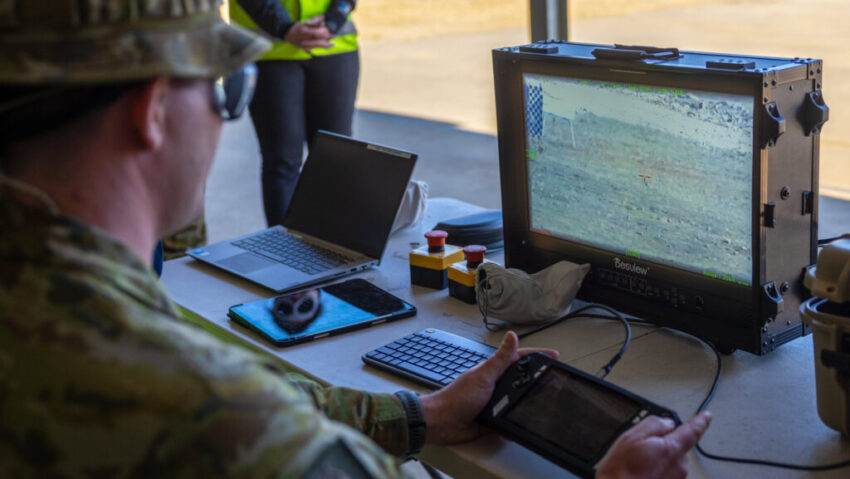Australian Army Corporal Patrick Flanagan operates the AIM Defence Counter-UAS Directed Energy Weapons System during a demonstration at the Puckapunyal Military Area, Australia. (Credit: CPL Jacob Joseph/Australian Department of Defence)
MELBOURNE — Less than a year after inviting tenders for a program to rapidly acquire a suite of counter-Unmanned Aircraft Systems (c-UAS) capabilities, Australia has issued an initial rolling wave of contracts, totalling $16.9 million AUD ($11.2 million USD) to 11 companies to start.
“This will see some of the world’s most capable threat detectors and drone-defeating platforms rapidly be introduced into service by the ADF (Australian Defence Force)”, Australian Minister for Defence Industry Pat Conroy said at a drone racing showcase in the Australian capital Canberra.
Australia’s c-UAS contracts, issued under Project Land 156, after testing will see the introduction of “at least 120″ technologies, including offerings from five Australian firms, Conroy’s office said. The drone-defeating systems include the use of high-energy lasers, radio frequency jamming and ammunition-based systems to defeat small UAS threats.
The move comes amid a global drone and counter-drone spending spree, including in the US where Defense Secretary Pete Hegseth recently signed a memo that in part directed every US Army squad to be armed with small, one-way attack drones by the end of fiscal 2026. For its part, the Albanese administration in Australia said it plans to spend some $10 billion AUD on drones over the next decade, according to the Australian DoD.
Australia’s announcement did not list the eleven companies award the contract, but Conroy said as an example that Australia’s DroneShield has supplied its Drone Gun Mk 4 and RF Patrol system, which provides a lightweight detection and handheld jammer to disrupt the operations of drones.
Australia had only invited bidders to tender for contracts under Land 156 last November. The program envisages a complete system of electro-optic, active and passive radars, and acoustic and thermal sensors, all connected to a Command and Control (C2) system that cues effectors for engagement.
It will also seek a systems integration partner to manage the acquisition of a c-UAS system that will be used to counter NATO Class 1 and 2 standard air vehicles weighing up to 24 kilograms (53 lbs).
The partner will also conduct market analysis, and then will design, implement, manage and provide ongoing assurance of the capability, according to the invitation to tender. The invite had also said that Australia will continually upgrade and refresh capabilities to address emerging small UAS threats through the program.
The Department of Defence added today that it will announce further counter-drone acquisitions under Land 156 in the coming months, including contracts to deliver a command-and-control capability as well as the acquisition of additional advanced counter-drone sensors and effectors.
The procurement is being led by the Defence Department’s Electronic Warfare and Intelligence Systems Branch Joint Systems Division of its Capability Acquisition and Sustainment Group.
Australia has also embarked on the Advanced Strategic Capabilities Accelerator’s (ASCA) Mission Syracuse is also accelerating the development of capabilities to counter medium size drones and swarms of drones, providing cutting-edge future capability options for Land 156.
Click this link for the original source of this article.
Author: Mike Yeo
This content is courtesy of, and owned and copyrighted by, https://breakingdefense.com and its author. This content is made available by use of the public RSS feed offered by the host site and is used for educational purposes only. If you are the author or represent the host site and would like this content removed now and in the future, please contact USSANews.com using the email address in the Contact page found in the website menu.








